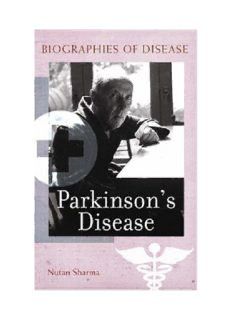
Parkinson's Disease (Biographies of Disease) PDF
Preview Parkinson's Disease (Biographies of Disease)
PARKINSON’S DISEASE Nutan Sharma BiographiesofDisease JulieK.Silver,M.D.,SeriesEditor GREENWOODPRESS Westport,Connecticut x London Libraryof Congress Cataloging-in-Publication Data Sharma, Nutan. Parkinson’s disease /Nutan Sharma. p. ;cm.—(Biographies ofdisease, ISSN 1940-445X) Includes bibliographical references and index. ISBN-13: 978-0-313-34217-2 (alk.paper) 1. Parkinson’sdisease. I.Title.II. Series. [DNLM: 1.ParkinsonDisease. WL359S531p2008] RC382.S4772008 616.8033—dc22 2007048657 BritishLibrary Cataloguing inPublication Data isavailable. Copyright (cid:2)C 2008byNutanSharma Allrights reserved. Noportionof thisbookmay be reproduced, byany process ortechnique, withoutthe express written consentofthe publisher. Library ofCongress Catalog Card Number:2007048657 ISBN:978-0-313-34217-2 ISSN:1940-445X First publishedin 2008 Greenwood Press,88Post RoadWest,Westport, CT06881 An imprintofGreenwood PublishingGroup, Inc. www.greenwood.com Printedin theUnited States ofAmerica Thepaper usedinthis bookcomplies with the Permanent Paper Standardissued bythe National Information StandardsOrganization (Z39.48–1984). 10 9 8 7 6 5 4 3 2 1 Tomyson,VikramE.Aldykiewicz,whoisalwayspatientandgood-natured whenhisplaytimegetsinterruptedbymywork Contents SeriesForeword ix Preface xi Introduction xiii Chapter1. Parkinson’sDiseaseDefined 1 TheHistoryofParkinson’sDisease 3 TheAnatomyofParkinson’sDisease 5 PossibleCauses 6 SignsandSymptoms 9 Chapter2. TheDiagnosisofParkinson’sDisease 15 NeurologicalExam 16 MakingtheDiagnosis 19 ClinicalCharacteristicsofParkinson’sDisease 21 Chapter3. HowDoesSomeoneGetParkinson’sDisease? 29 GeneticsasaRiskFactor 30 EnvironmentalRiskFactors 34 AgingasaTrueRiskFactor 35 viii Contents LifestyleFactorsThatMayReducetheRiskofDeveloping Parkinson’sDisease 36 Chapter4. TheTreatmentofParkinson’sDisease 37 PhysicalTherapy 38 OccupationalTherapy 40 SpeechTherapy 43 MedicalTreatment 45 SurgicalTreatment 50 Chapter5. TheCourseandComplicationsofParkinson’sDisease 59 MotorComplications 61 NonmotorComplications 66 Chapter6. ComplementaryandAlternativeTherapiesfor Parkinson’sDisease 83 TheUseofComplementaryMedicineinParkinson’sDisease 84 Chapter7. HowParkinson’sDiseaseAffectstheFamily 91 CopingSkills 92 WhenIn-HomeHelporSkilledNursingCareIsRequired 96 Chapter8. ScientificandClinicalResearchinParkinson’sDisease 101 TheLongRoadtoMarket 104 TheHistoryoftheFDAandtheDrugApprovalProcess 104 StudiesoftheHumanBrain 106 Chapter9. CaseStudiesinParkinson’sDisease 107 Ben 107 Melina 108 Eduardo 109 Kamla 110 Sophia 111 Alec 112 JuniorHighSchoolDance 113 SchoolGraduation 115 Wedding 116 Resources 119 Timeline 127 Glossary 129 Bibliography 141 Index 143 Series Foreword E very killer has a story to tell, and so it is with diseases as well: about how it started long ago and began to take the lives of its innocent vic- tims, about the way it hurts us, and about how we are trying to stop it. In this Biographies of Disease series, the authors tell the stories of the diseases that wehave cometo knowand fear. The stories of these killers have all of the components that make for great literature. There is incredible drama played out in real-life scenes from the past, present, and future. You’ll read about how men and women of science stumbled trying to save the lives of those they aimed to protect. Turn the pages and you’ll also learn about the amazing success of those who fought the killerandwon, saving thousands oflives intheprocess. If you don’t want to be a health professional or research scientist now, when you finish this book you may think differently. The men and women in this book are heroes who often risked their own lives to save ours. This is the biographyofakiller,butitisalsothestoryofreal peoplewhomadeincredible sacrifices tostopit initstracks. JulieK. Silver, M.D. Assistant Professor, Harvard Medical School Department ofPhysical Medicine and Rehabilitation Preface T his book is intended to educate the reader about Parkinson’s disease. The history of Parkinson’s disease, what is known about the causes of Parkinson’s disease, and medications used to treat it are discussed in detail. Current scientific and medical research and the state of promising new therapies, such as stem cells, are discussed using language that is understanda- ble tothelayreader. The bookalso contains numerous case studiesthat illustrate how thosewho have Parkinson’s disease experience and cope with it. These case studies are drawn from actual cases that the author has encountered. However, names and other identifying characteristics have been changed to protect the privacy of those involved. The goal of these case studies is to put the reader in the shoes of someone with Parkinson’s disease, to understand how it impacts daily life.
Description: